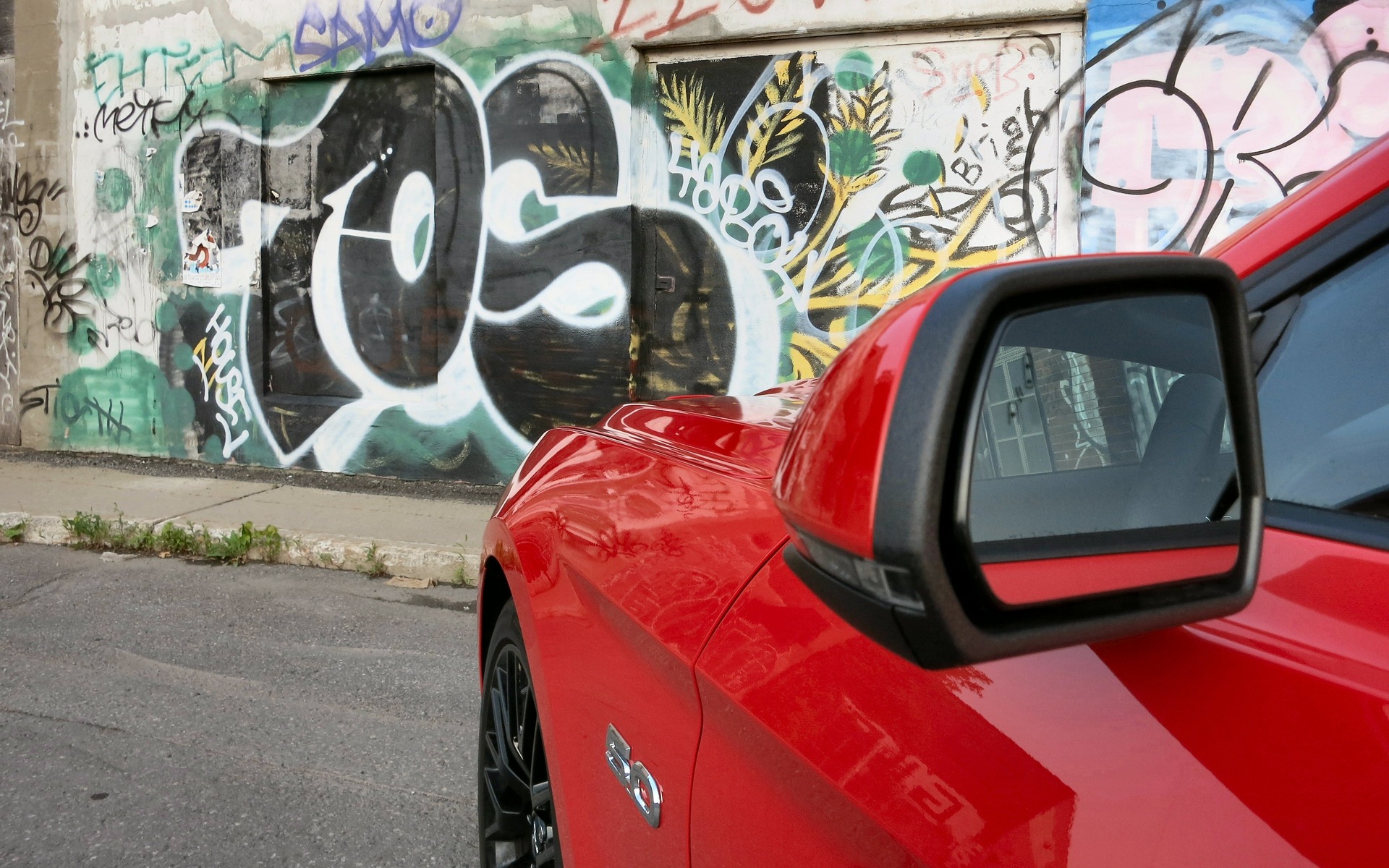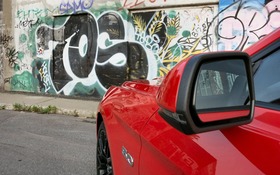2015 Ford Mustang GT: In Over My Head

| Strong points |
|
|---|---|
| Weak points |
|
Darkness has fallen, and the drag strip is illuminated only by a series of yellowed overhead lamps, their faint illumination obscured by the legions of mosquitoes and moths they've attracted with their false promise of shelter. I'm in the driver's seat of a 2015 Ford Mustang GT with barely 5,000 kms on the clock, one hand on the shifter, the other on the wheel. In the lane to the left, there sits a much older 'Stang, Fox-body vintage. With a parachute.
The PA system chatters overhead, the words barely intelligible over the feedback blaring from the speaker towers. The smoke from the Fox's seemingly endless burnout still lingers, blowing past the front fenders of my showroom stock Mustang like mist over an asphalt cemetery path.
- Also: Fisker Unveils The Rocket Speedster
- Also: 2016 Ford Mustang GT King Edition: The King's Mustang
There's money on the line here.
How did I get myself into this situation?
Fun For Everyone - No Parachute Necessary*
The short answer to that question is, 'bracket racing.' When I pulled up to Napierville Dragway that Wednesday evening in July, I didn't know that I was about to enter the 2015 Ford Mustang GT I had borrowed for the week in 'Mustang Night Shootout,' an event that had apparently attracted 90 percent of pony car owners within a 50 kilometre radius of the strip. After paying my $20 admission, I was told that not only would I have the chance to run the coupe down the 1320 to get a few baseline times - which had been my original plan - but that at 9 pm I'd have to take my place in the qualifying line for the 'Shootout' itself.
I weighed the odds. On the one hand, I was piloting the latest-generation version of Mustang, a muscle car that had been completely redesigned for the 2015 model year to offer a brand new platform, extra grunt under the hood from its 5.0-liter V8, and a first-time-ever launch control system linked to its six-speed manual transmission. On the other, I had virtually no experience with the Ford in a high performance situation, and on the drag strip familiarity with your equipment can often bridge the thousandth of a second gap between winning and losing. Then there was the question of the Mustang GT's newly independent rear suspension system, a chassis perk coveted for its comfort and handling benefits but not nearly as competent launching from a dig as the live-axle setup it replaced.
Still, I liked my chances. Launch control systems have a way of imparting over-confidence, especially on a prepared surface where traction wouldn't be at a premium. Besides, this wouldn't be my first time down the quarter mile. Challenge accepted.
Things Start To Unravel
Letting the computer slip the clutch for you in the 2015 Ford Mustang GT is a relatively simply process. Simply hit the drive mode button, select 'Race,' which turns off the car's traction and stability control features, and then use the Track Apps screen in the gauge cluster to choose which engine RPM you want the car to launch at (you can choose between 3,000 and 4,500 RPM). Once that's done, it's an 'always on' system, which means all you have to do is clutch in (launch control is only offered with manual transmission cars), pin the throttle to the floor, and then violently release the third pedal within a reasonable interval. Theoretically, the computer then achieves the best possible trade-off between acceleration and traction in a straight line.
In practice, the Mustang's launch control proved to be underwhelming. My first practice run at 4,000 revs saw a pregnant pause before the engine dumped power to the rear wheels with a 'whump,' the differential dancing and twitching towards a 13.4-second run at 108 miles per hour. Puzzled - this was well outside the performance window Ford's marketing materials had promised me - I repeated the effort again and again, experimenting with lane choice and lowering launch RPM, but after a single 13.2-second blast the car settled back into the same mid-13 groove. Frustrated, I took matters into my own hands and launched the car the old fashioned way, slipping the clutch myself and achieving a time of 13.1-seconds - better, but still not the sub-13 I was hunting for, a number that would elude me all night.
Consistency Is Everything
Winning at bracket racing is simple, really. The system allows for two cars of vastly disparate quarter mile potential to line up against each other by staggering the green light for each lane based on whatever you tell the stewards your car will run. This means as long as you know exactly how quick your car is, and can repeat a particular time again and again, it becomes a driver's race of reaction times, traction, and consistency.
Unfortunately for me, 'consistency' wasn't in my vocabulary when behind the wheel of the redesigned 'Stang. Hoping for the best after my launch control experiences, I erred on the side of caution and gave a time of 13.4 to track officials during bracket qualifying. Running quicker than this time would reveal me as a sandbagger, and get me disqualified. Putting in a slower performance would see me eaten alive by a driver who knew what their ride was capable of and had dialled-in the right numbers.
The first race - against 2012 Mustang coupe - wasn't a complete disaster, but I got on the throttle too hard in the first 60 feet, pinning a 13.5 to the LED scoreboard at the end of the track and losing the heat to my rival. Rolling up immediately to the start of the line again (the car had spent the last 20 minutes cooling down in preparation for the main event), I decided that maybe I'd give launch control one last chance.
Comedy of (Human) Errors
Which brings me back to my epic showdown with the parachute-wearing 'vert to my left. Surely, I thought, this would be a battle for the ages, with the hyper-muscled 5.0 unable to come from behind and wipe out my Mustang as long as launch control did its job and hooked up my rear tires right when I needed it most.
With both of us staged, the tree began to count down to green. Both cars hummed with varying degrees of fury, with my opponent holding his transbrake as his open headers threatened to shake apart the grandstands. Revs locked at 3,500, I tensed the muscles in my left leg, balanced them on the clutch, and as the last tiny yellow bulb dimmed in preparation for GO! GO! GO! I steeled myself and -
- shifted the car into second gear. Foot still on the clutch. Engine still pegged. Through my brain freeze, I watched in disbelief as the other Mustang rocketed off of the line a second later, then, cursing, I shifted back into first and released the clutch pedal. All in vain, of course, because there's not a launch control system in the world that can open a portal in space/time and let you travel back even just a few seconds to slap yourself in the face before you can embarrass yourself in front of an audience of pony car super-fans.
I limped back up the return road, pausing to collect my time slip in disgust, and parked the Ford in the dark beside a pair of Mustang IIs that had been trailered to the track together to remind the world that the Pinto was never a great sports car. Did I even deserve their company? Probably not, but losers can't be choosers. All around me, the Mustang circus continued, my pathetic pair of runs forgotten by the throngs of drivers un-flummoxed by launch control, independent rear suspensions, and radar adaptive cruise control systems (now on the 2015 options sheet). I sat there for a few minutes, envying their simple pleasures, before meekly turning on the AC, setting the cruise to 120 km/h, and heading back home, tail tucked between my legs and lesson learned: never try to tame a stallion with just a few lines of code when the spurs on your boots will do the job that much better.











